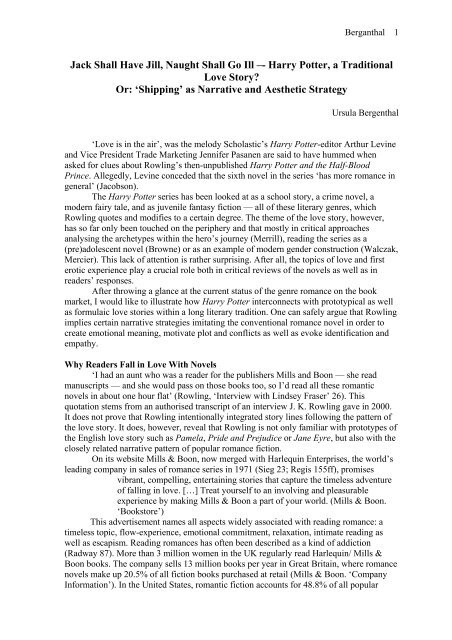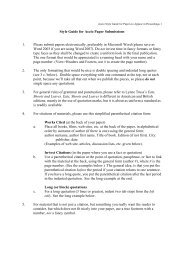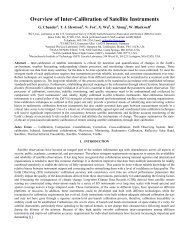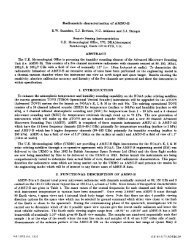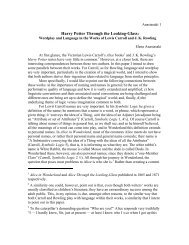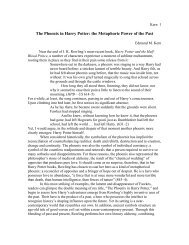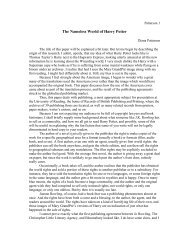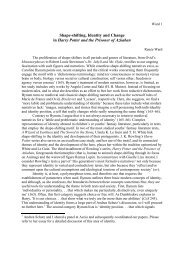Jack Shall Have Jill, Naught Shall Go Ill â- Harry Potter ... - Accio 2005
Jack Shall Have Jill, Naught Shall Go Ill â- Harry Potter ... - Accio 2005
Jack Shall Have Jill, Naught Shall Go Ill â- Harry Potter ... - Accio 2005
Create successful ePaper yourself
Turn your PDF publications into a flip-book with our unique Google optimized e-Paper software.
Berganthal 1<br />
<strong>Jack</strong> <strong>Shall</strong> <strong>Have</strong> <strong>Jill</strong>, <strong>Naught</strong> <strong>Shall</strong> <strong>Go</strong> <strong>Ill</strong> –- <strong>Harry</strong> <strong>Potter</strong>, a Traditional<br />
Love Story?<br />
Or: ‘Shipping’ as Narrative and Aesthetic Strategy<br />
Ursula Bergenthal<br />
‘Love is in the air’, was the melody Scholastic’s <strong>Harry</strong> <strong>Potter</strong>-editor Arthur Levine<br />
and Vice President Trade Marketing Jennifer Pasanen are said to have hummed when<br />
asked for clues about Rowling’s then-unpublished <strong>Harry</strong> <strong>Potter</strong> and the Half-Blood<br />
Prince. Allegedly, Levine conceded that the sixth novel in the series ‘has more romance in<br />
general’ (Jacobson).<br />
The <strong>Harry</strong> <strong>Potter</strong> series has been looked at as a school story, a crime novel, a<br />
modern fairy tale, and as juvenile fantasy fiction — all of these literary genres, which<br />
Rowling quotes and modifies to a certain degree. The theme of the love story, however,<br />
has so far only been touched on the periphery and that mostly in critical approaches<br />
analysing the archetypes within the hero’s journey (Merrill), reading the series as a<br />
(pre)adolescent novel (Browne) or as an example of modern gender construction (Walczak,<br />
Mercier). This lack of attention is rather surprising. After all, the topics of love and first<br />
erotic experience play a crucial role both in critical reviews of the novels as well as in<br />
readers’ responses.<br />
After throwing a glance at the current status of the genre romance on the book<br />
market, I would like to illustrate how <strong>Harry</strong> <strong>Potter</strong> interconnects with prototypical as well<br />
as formulaic love stories within a long literary tradition. One can safely argue that Rowling<br />
implies certain narrative strategies imitating the conventional romance novel in order to<br />
create emotional meaning, motivate plot and conflicts as well as evoke identification and<br />
empathy.<br />
Why Readers Fall in Love With Novels<br />
‘I had an aunt who was a reader for the publishers Mills and Boon — she read<br />
manuscripts — and she would pass on those books too, so I’d read all these romantic<br />
novels in about one hour flat’ (Rowling, ‘Interview with Lindsey Fraser’ 26). This<br />
quotation stems from an authorised transcript of an interview J. K. Rowling gave in 2000.<br />
It does not prove that Rowling intentionally integrated story lines following the pattern of<br />
the love story. It does, however, reveal that Rowling is not only familiar with prototypes of<br />
the English love story such as Pamela, Pride and Prejudice or Jane Eyre, but also with the<br />
closely related narrative pattern of popular romance fiction.<br />
On its website Mills & Boon, now merged with Harlequin Enterprises, the world’s<br />
leading company in sales of romance series in 1971 (Sieg 23; Regis 155ff), promises<br />
vibrant, compelling, entertaining stories that capture the timeless adventure<br />
of falling in love. […] Treat yourself to an involving and pleasurable<br />
experience by making Mills & Boon a part of your world. (Mills & Boon.<br />
‘Bookstore’)<br />
This advertisement names all aspects widely associated with reading romance: a<br />
timeless topic, flow-experience, emotional commitment, relaxation, intimate reading as<br />
well as escapism. Reading romances has often been described as a kind of addiction<br />
(Radway 87). More than 3 million women in the UK regularly read Harlequin/ Mills &<br />
Boon books. The company sells 13 million books per year in Great Britain, where romance<br />
novels make up 20.5% of all fiction books purchased at retail (Mills & Boon. ‘Company<br />
Information’). In the United States, romantic fiction accounts for 48.8% of all popular
Berganthal 2<br />
paperback fiction sales, and 33.8% including hardcover as well as trade publications<br />
(Romance Writers of America, hereafter RWA). In comparison, Science Fiction and<br />
Fantasy comprise only 6%, Mystery, Detective and Suspense 25.6% off all popular fiction<br />
(RWA). In 2003, the genre romance has generated more than $1.41 billion for US<br />
publishers (RWA). Often sold at grocery stores or supermarkets, where they are placed in<br />
stacks next to chocolate and washing-up liquid, formulaic romance novels are treated as<br />
products for mass-consumption rather than as original literary artworks. But why do these<br />
formulaic novels that are either condemned or simply neglected by critics appeal to such a<br />
huge readership? What is their emotional potential? And where lie their literary roots?<br />
Chivalric Romances<br />
If the book market nowadays refers to the genre ‘romance’ it is using a term which<br />
has been coined in other contexts: Medieval or chivalric romances deal with the adventures<br />
of noble knights who slay dragons, rescue maidens and encounter (supernatural)<br />
adventures as they try to win the favour of a scornful (often married) lady. Unfulfilled,<br />
chaste sentiments characterise this practise of worship from afar. This courtly love is often<br />
part of a literary tradition referred to as quest — an episodic pattern that influenced the<br />
genre high fantasy, and a pattern that can be found in <strong>Harry</strong> <strong>Potter</strong>. When <strong>Harry</strong> slays the<br />
Basilisk he uses his trophy, the Basilisk’s fang, to kill the dark knight (Tom Riddle) and to<br />
rescue the maiden (Ginny). Fate — or rather narrative strategy — demands that <strong>Harry</strong> gets<br />
hold of a typical chivalric equipment, a ‘gleaming silver sword […] its handle glittering<br />
with rubies the size of eggs’ (CoS 235). It is a weapon that, like a modern Excalibur, solely<br />
the chosen knight knows how to use, as ‘[o]nly a true Gryffindor could have pulled that out<br />
of the Hat’ (CoS 245). In the end, <strong>Harry</strong>’s heroism wins him even deeper admiration from<br />
Ginny, and also Myrtle, a female ghost, is ‘fond’ (CoS 240) of him. Thus, Ginny’s as well<br />
as Myrtle’s teenage crushes for <strong>Harry</strong> are integrated into the conventional storyline of<br />
courtly love to underline the characterisation of <strong>Harry</strong> as a noble, honourable hero.<br />
The medieval quest also serves as a narrative pattern for the Triwizard Tournament,<br />
where pupils have to — like Arthurian knights — fulfil tasks before returning to the castle<br />
and winning the favour of their beloved. Chivalric courtship is reproduced when <strong>Harry</strong><br />
rescues not only Ron from the merpeople but also Fleur’s younger sister, a helpless<br />
maiden. <strong>Harry</strong>’s courage wins him extra points as well as kisses from ravishing beauty<br />
Fleur Delacour (<strong>Go</strong>F 439ff). Similar to the medieval quest, womanly admiration in <strong>Harry</strong><br />
<strong>Potter</strong> serves as a reward for the courageous hero. Rescuing maidens motivates the<br />
episodic pattern and is, therefore, mainly a function of the narrative plot that Rowling’s<br />
series relies on. Rowling implies that several figures embody the maiden ‘in order to<br />
complete the individual story arcs within each book’ (Merrill 73).<br />
Courtly love is a literary trope that has not only influenced our tradition of story<br />
telling until today but also our modern concept of romantic, true affection. In a narrative<br />
twist of different genre conventions (medieval romance/ high fantasy, love story,<br />
adolescent novel), Rowling intertwines teenage admiration with a conventional concept of<br />
higher love and heroic chivalry.<br />
‘The course of true love never did run smooth’ (A Midsummer Night’s Dream 1.1)<br />
Besides these chaste sentiments between maidens and knights, the battle of the<br />
sexes, intrigues, as part of a vicious plan, as well as misunderstandings form important<br />
building blocks of the romance for modern readers. Defined as ‘a work of prose fiction that<br />
tells the story of the courtship and betrothal of one or more heroines’ (Regis 19), the<br />
romance novel focuses on the relationship between a woman and a man, surrounded by<br />
various prototypical characters. The pattern of ‘holding-something-back-until-the-finalfervent-clinch’<br />
(Cadogan 298) grips the reader’s attention and heightens emotional
Berganthal 3<br />
suspense. Accordingly, in interviews, Rowling hints at possible ‘ships’, at emotional plots<br />
and romantic episodes: When asked ‘So... will <strong>Harry</strong> be receiving a second kiss in his last<br />
two years at Hogwarts? ; )’ Rowling replied, ‘He might well be receiving another kiss (or<br />
two) but I’m not saying who the kisser’s going to be ...’ (Rowling, ‘World Book Day<br />
Chat’). Rowling holds back information, and by doing so, stimulates the emotional<br />
suspense of her readers.<br />
An elaborate, cleverly devised narrative process of courting defines not only<br />
Shakespeare’s so-called happy or romantic comedies, Samuel Richardson’s epistolary<br />
novel Pamela; or, Virtue Rewarded or prototypical works by Jane Austen and the Brontë<br />
sisters, but thus also influenced the formula of modern popular romances. Often, characters<br />
initially fall in love with the wrong person as they first need to discover the worth of true<br />
love. In a chat-interview, Rowling related to this formula: ‘I’m having so much fun writing<br />
Book 4 because for the first time <strong>Harry</strong>, Ron, and Herm[io]ne are starting to recognize<br />
boys and girls as boys and girls. Everyone is in love with the wrong people’ (Barnes and<br />
Noble).<br />
Social and monetary restraints, external obstacles or prejudices in partnership<br />
repeatedly foil the realisation of true affection and affinity. After all, as Lysander in A<br />
Midsummer Night’s Dream puts it, the ‘course of true love never did run smooth’, and in<br />
the end it is the overcoming of difficulties that distinguishes a relationship. ‘Courting’ in<br />
<strong>Harry</strong> <strong>Potter</strong> appears to be a clever mixture of imitating teenage coming-of-age and<br />
quoting literary conventions.<br />
Yellow press journalist Rita Skeeter, for example, is portrayed as the stereotypical<br />
female intriguer who, like the mean stepmother or the mischievous women in Jane<br />
Austen’s novels, accounts for the obstacles that typically inhibit a smooth development of<br />
relationships. In an article entitled ‘HARRY POTTER’S SECRET HEARTACHE’ she is<br />
spreading rumours, calling Hermione his ‘steady girl-friend at Hogwarts’ who ‘seems to<br />
have a taste for famous wizards’ such as <strong>Harry</strong> and Krum, and thus ‘has been toying with<br />
both boys’ affections’ (<strong>Go</strong>F 444). She discredits Hermione as a, as Ron puts it, ‘scarlet<br />
woman’ (<strong>Go</strong>F 445), who as a result receives offensive anonymous letters (<strong>Go</strong>F 470ff.).<br />
At all times in literature, the manners of affectionate lovers does not comply with<br />
common social norms. This deviation from normal behaviour also accounts for humorous<br />
episodes. Aware of the benefit of this narrative strategy, Rowling integrates stock<br />
characters and describes highly conventional episodes in all of her books. At first glance,<br />
Luna Lovegood is a caricature of the esoteric dreamer, who embodies, as her name<br />
indicates, a harmless lunatic lover (OotP 500). And when Hermione and Ron start teasing<br />
each other, readers are very aware that this behaviour only conceals their mutual affection.<br />
When Ron initially falls for Fleur, Hermione accuses him of ‘gaping at her like an idiot!’<br />
(<strong>Go</strong>F 222), and later remarks he has ‘the emotional range of a teaspoon’ (OotP 406).<br />
Being criticised for a conservative gender concept, Rowling stresses Hermione’s<br />
strength: ‘Just recently, someone asked me why I don’t have stronger female characters<br />
and I was offended, because I consider Hermione (<strong>Harry</strong>’s goody-goody, but fearless,<br />
sidekick) quite strong’ (Rowling, ‘Interview with Dan Hulbert’). However, Hermione<br />
being witty and eloquent — whereas Ron embodies the typical foolish admirer — also<br />
follows conventional literary patterns of the genre as seen in Shakespeare’s comedies,<br />
where the socially uncontrolled period of courtship allows women to subvert male<br />
dominance.<br />
The conventional romance plot of prejudice and crossing social boundaries as well<br />
as the literary knowledge of villains turning into heroes also shapes the expectations of<br />
certain readers who believe that Draco Malfoy might be a rewarding match for either<br />
Hermione or Ginny. Both female characters comply with the requirements of an antithetic<br />
or oppositional partner: Hermione as a mudblood is of different birth, Ginny of different
Berganthal 4<br />
social position. A young shipper even names a literary prototype as a frequent argument for<br />
the ship Ginny/Malfoy: ‘It’s forbidden like Romeo and Juliet’ (Barker, ‘Frequent<br />
Reasons’).<br />
The typical ‘romantic’ hero in the tradition of Mr Rochester, Mr Darcy or Rhett<br />
Butler 1 is incarnated by Victor Krum. At first glance these heroes are all moody, sarcastic,<br />
arrogant, yet much admired and after all sensitive masters who appeal to women as the<br />
type of men yet to be tamed. Dismissive manners only serve to enhance their desirability.<br />
Like Mr Rochester, Victor is not the prototype of the handsome young hero, but a character<br />
attractive only at second sight. Jane Eyre describes Rochester having ‘a dark face, with<br />
stern features and a heavy brow; his eyes looked ireful and thwarted […]’ (Brontë 129).<br />
Later she adds ‘I recognized his decisive nose, more remarkable for character than beauty;<br />
[…] his grim mouth, chin, and jaw — yes, all three were very grim’ (137). Victor’s looks<br />
are described as ‘a very surly face with heavy black eyebrows’ (<strong>Go</strong>F 77) and a ‘prominent,<br />
curved nose’ (218). On seeing him on a poster, Hermione, his subsequent admirer,<br />
comments that Krum ‘looks really grumpy’ (77).<br />
While other girls are wondering whether ‘he’d sign [their] hat in lipstick’ (219),<br />
Hermione considers herself as someone not falling for fanatic adoration: ‘For heaven’s<br />
sake, Ron, he’s only a Quidditch player’ (219). Both Rochester (Brontë 153) and Victor<br />
seem attracted by womanly indifference, by female self-confidence and intelligence — a<br />
pattern reused in many modern formulaic romance novels and romantic films. After all,<br />
statistics prove that most readers of romance novels appreciate firstly intelligent heroines,<br />
secondy their ‘[s]trength of character’ and only thirdly ‘[a]ttractiveness’, whereas they<br />
named first ‘[m]uscle bound’, second ‘[h]andsomeness’, third ‘[i]ntelligence’ as important<br />
traits of male heroes (RWA).<br />
‘Reader, I married him.’ (Brontë 498)<br />
Many critics argue that formulaic romance novels offer and stabilise conservative<br />
values and at the same time de-liberate or even enslave women in our post-feminist<br />
society. Rejecting the happy ending as a confirmation of the status quo, critics consider<br />
that the conclusion of a story is not only a question of thematic or cultural imprint but also<br />
of narrative strategy. Romance Writers of America define the romance novel ‘as a book<br />
[…] that has an emotionally satisfying ending that results from a positive resolution to the<br />
central love story.’ (RWA)<br />
Rowling needs to meet the expectations of her readers, and the death of Cedric<br />
‘Pretty-Boy’ Diggory (<strong>Go</strong>F 230) was a real challenge for readers used to formulaic<br />
(romance) novels in which only villains perish. Asked for their motivation, a majority of<br />
regular romance readers named the act of reading — indulging in a plot that is idealised,<br />
optimistic and will necessarily lead to a happy ending — as more important than the<br />
individual narrative itself (Radway 86–100). This might also partly apply to readers of<br />
<strong>Harry</strong> <strong>Potter</strong>.<br />
‘You and you are sure together / As the winter to foul weather.’ (As You Like It 5.4)<br />
Comic relief is often inherent within the tradition of the genre. In Shakespeare’s<br />
comedies we are confronted with aristocratic protagonists whose courtships are mirrored<br />
by the burlesque battle of sexes between people from a lower class. Besides highlighting<br />
the deeper meaning of the central courtship, these symmetrical constellations allow for<br />
comic relief, funny implications as well as farcical, often fescennine sub-plots — relics<br />
1 Mary Cadogan differentiates these different literary male role-models more thoroughly<br />
(15-17).
Berganthal 5<br />
from the tradition of the commedia dell’arte. Hagrid and Madame Maxime serve as a<br />
counter-couple in every sense: Compared to the teenage protagonists they are firstly adults,<br />
secondly of different social or cultural background, and thirdly, stemming from giantfamilies,<br />
they are half-bloods. Hagrid impersonates the foolish lover when he is ‘wearing<br />
his best (and very horrible) hairy brown suit, plus a checked yellow and orange tie’, ‘using<br />
large quantities of what appeared to be axle grease’ for his hair and an ‘eau-de-Cologne’<br />
with a ‘truly horrible smell’ in order to impress his beloved (<strong>Go</strong>F 232, 234). Their function<br />
as humorous byplay is also reflected in their character-speech: Hagrid has a rural (West<br />
Country) dialect, whereas Maxime’s French accent sounds rather priggish — another<br />
discrepancy causing exhilaration among readers.<br />
This combination of different moods, tone and style adds to the entertaining<br />
complexity of Rowling’s novels. The tête-à-tête of Hagrid and Madame Maxime at the<br />
Yule Ball for example serves as a parody of the formulaic romance pattern. The setting is<br />
an exaggeratedly romantic spot with ‘a large stone reindeer’ and ‘the sparkling jets of a tall<br />
fountain’: ‘The shadowy outlines of two enormous people were visible on a stone bench,<br />
watching the water in the moonlight’ (371). Ron and <strong>Harry</strong> as concealed listeners are<br />
aware that this is not ‘the sort of scene they ought to walk in on, somehow…’ (371). When<br />
Hagrid remarks ‘Momen’ I saw yeh, I knew’, the couple gets caught up in a conversation<br />
of erotic tension. As the counter-couple, however, they fulfil their duty as comic relief in<br />
the form of yet another parody: When Hagrid asks Madame Maxime about her origin as a<br />
half-giant, he unconsciously breaks a taboo. Madame Maxime’s reaction quotes<br />
conventional excuses for another stereotypically female problem, the fear of overweight: ‘I<br />
’ave nevair been more insulted in my life! ’Alf-giant? Moi? I ’ave – I ’ave big bones!’<br />
(373). A scene that — apart from the half-giant remark — might stem from Bridget Jones’<br />
Diary or a TV comedy series.<br />
By adding an ironic or humorous perspective — and thus an extra dimension for<br />
adult readers who are rarely interested in preadolescent matchmaking — Rowling plays<br />
with the material of the traditional love story without, however, deconstructing the<br />
macrostructure of the genre.<br />
A Global Love Affair<br />
In <strong>Harry</strong> <strong>Potter</strong> the love story also accommodates its worldwide readership in that,<br />
so far, matchmaking focuses on intercultural relationships: <strong>Harry</strong> falls in love with<br />
presumably Asian Cho Chang, Ron with French Fleur Delacour, Hermione with the<br />
Bulgarian Victor Krum, Hagrid with the French headmistress Madame Maxime. Even the<br />
couples forming for the Yule Ball are bi-cultural: <strong>Harry</strong> asks Parvati Patil out, Ron her<br />
twin sister Padma, and Cedric wins Cho Chang’s favour. Rowling thus integrates relevant<br />
storylines like globalisation and multiculturalism without overtly moralising or preaching.<br />
The message is rather stereotypical: Love can cross all boundaries — in times of modern<br />
globalisation these boundaries are also cultural ones.
Berganthal 6<br />
‘Come, come, we are friends, let’s have a dance ere we are married, that we may<br />
lighten our own hearts and our wives’ heels.” (Much Ado About Nothing, 5.4)<br />
‘Yule Ball is a huge event and so many couples formed after that,’ explained Jenna<br />
when asked for romance in <strong>Harry</strong> <strong>Potter</strong> (Barker, ‘answer’). On her website she comments<br />
on <strong>Go</strong>blet of Fire: ‘This book is my favorite of the series. It has everything a book needs:<br />
rivalry, heartbreak, jealousy, action, romance, […] etc’ (Barker, ‘Book Information’). The<br />
central event, the Yule Ball, is indeed an episode of highly melodramatic, almost kitschy<br />
atmosphere. Shakespeare’s comedies as well as formulaic romantic films end with either<br />
marriage or dancing, and music is typically associated with the genre, as it is said to better<br />
reflect passionate feelings. Dancing not only gives opportunity to physical closeness, but<br />
also to dressing up as the multimedia-omnipresent story of Cinderella suggests. Rowling<br />
herself rouses connotations with American high-school movies where dating the [sports]<br />
star at the school ball serves as a reward for modern Cinderella: ‘They’re all kind of after<br />
the wrong people, as in life. Hermione gets the first date, and it’s quite a cool one because I<br />
thought I owed her a bit of fun’ (Rowling, ‘Interview with Nancy Gilson’). At the Yule<br />
Ball, Hermione reveals her beauty as opposed to her brainpower, represented by books:<br />
She had done something with her hair; it was no longer bushy, but sleek and<br />
shiny, and twisted up into an elegant knot at the back of her head. She was<br />
wearing robes made of a floaty, periwinkle-blue material, and she was<br />
holding herself differently, somehow — or maybe it was merely the absence<br />
of the twenty or so books she usually had slung over her back. (<strong>Go</strong>F 360)<br />
It remains to be seen how these episodes will be highlighted in the film version of<br />
<strong>Go</strong>blet of Fire. Their relevance, however, is already reflected in the reaction of fans who<br />
create websites named ‘Yule Ball’, draw impressive pieces of fan art, and offer sections<br />
with ‘soundtracks’ (Olga) that would fit their favourite couple. Rowling makes clever use<br />
of highly conventional, yet emotionally involving topics that suit literary as well as<br />
multimedia-based expectations, and thus have become extremely popular in shipping<br />
debates, fan art as well as fan (slash) fiction.<br />
‘Here’s looking at you, kid.’ (Casablanca, 1942)<br />
Besides the influence modern media aesthetics have on our interpretation of<br />
Rowling’s series, the adaptation of the texts for other types of media illustrates the<br />
different interactions. Especially in film, adaptations aspects of love and emotional<br />
commitment are highlighted as they serve as easily visualised storylines. In the film <strong>Harry</strong><br />
<strong>Potter</strong> and the Prisoner of Azkaban, to name but one example, Ron and Hermione start<br />
holding hands and exchanging deep looks, whereas in the books even in the fifth novel<br />
Ron’s and Hermione’s evolving attraction is only carefully anticipated.<br />
When asked if the films ‘show more or less romance than the books?’ <strong>Harry</strong> <strong>Potter</strong><br />
fan Jenna remarked: ‘Way more romance. Personally, I didn’t know anything was going on<br />
between Ron and Hermione until the fourth book. In the movies, the 2nd movie indicate[s]<br />
a little tension, which for me is just weird. The whole handshake thing ...’ (Barker,<br />
‘answers’).<br />
A Question of Perspective<br />
Romance is ‘the most female of popular genres’ (Regis xii). Writers, readers and<br />
protagonists are usually female. 93% of all romance readers in the US are women, only 7%<br />
men (RWA) – similar figures apply to the UK and Europe. Conventionally, the romance<br />
novel employs either a [young] female first-person narrator or a third-person narrator,<br />
mostly combined with a feminine focalizer to guarantee identification and empathy.
Berganthal 7<br />
In <strong>Harry</strong> <strong>Potter</strong>, however, the focalizer is male. As readers we perceive Rowling’s<br />
fictional world through the eyes of <strong>Harry</strong>, the typical protagonist of the adventure or action<br />
story. We also know that the use of the initials J. K. on the book cover instead of her real<br />
name — Joanne Rowling — was a marketing strategy designed by her publisher as they<br />
thought ‘boys will like this book but we’re not sure that they’d pick it up if they think a<br />
woman wrote it’ (Rowling, ‘Interview with Sean Bullard’).<br />
Thus, Rowling and her publisher tried to de-feminise the text by a female author as<br />
they were — consciously or subconsciously — aiming to address readers beyond gender<br />
expectations. The reasons are manifest: Boys are rarely interested in stories focussing on<br />
female protagonists or stories written by female authors, whereas due to cultural imprint<br />
girls are more used to ‘reading across gender lines’ (Regis xii), and are thus adapting to the<br />
typically male literary hero.<br />
The focalizer Rowling employs as a narrative strategy is a teenage boy who reflects<br />
upon teenage romance. <strong>Harry</strong> <strong>Potter</strong> fan Jenna stresses that having a crush on someone is a<br />
relevant topic in teenage conversation, which Rowling tries to imitate ‘since the book is the<br />
author perspective of what <strong>Harry</strong> thinks and feels’ and ‘that’s what teenagers usually think<br />
about: Bob’s dating [S]ally?’ (Barker, ‘answers’).<br />
Pedagogical Concerns<br />
A great discrepancy in the readers’ reactions, however, is obvious. Parents and<br />
pedagogues have (re)started a highly controversial discussion about the role of love and<br />
‘sex’ in juvenile literature. Are those included in order to address a media-oriented<br />
premature readership? The concern that literary romance might demoralise young readers<br />
follows a long tradition. In defence of potential criticism the title page of the 1801 edition<br />
of Richardson’s Pamela notes it was ‘published in order to cultivate the principles of virtue<br />
and religion in the minds of the youth of both sexes’ (Richardson 27). Rowling, however,<br />
continuously stressed the fact that compared with Enid Blyton’s ‘hormone-free’ characters,<br />
the teenagers in her series are going through puberty, a time when attraction for the<br />
opposite sex is evolving (Rowling, ‘Interview with Christoph Dallach’).<br />
As a matter of fact, a journalist of the Guardian assumed that ‘[t]he promise of<br />
teenage romance in future [<strong>Harry</strong> <strong>Potter</strong>] books is likely to further inflame the anger of<br />
those who argue that Rowling’s bestsellers are already unsuitable for children for their<br />
portrayal of the supernatural’ (Yates). Rowling will, I dare say, not portray conflicts like<br />
teenage pregnancy or drug abuse. Alcoholism is only mentioned in the subplot quarrels<br />
between house elves Winky and Dobby (<strong>Go</strong>F 466), who also serve as a counter-couple and<br />
whose problems are thus taken as comic relief rather than as serious topics of social<br />
relevance. In <strong>Harry</strong> <strong>Potter</strong>, teenage romance is neither tabooed nor moralised by an<br />
omniscient narrator or adult character.<br />
So far, Rowling writes rather light-heartedly about affections, and utilises literary<br />
conventions to form an emotionally gripping as well as amusing plot. She relies on the rich<br />
literary tradition of romance and the advantages of an emotionally satisfying genre that is<br />
meeting readers’ expectations — because, as Anthony Trollope once wrote, ‘[t]here is no<br />
happiness in love except at the end of an English novel’ (Trollope Ch. 27).<br />
Works Cited<br />
Barker, Jenna. ‘the answer to ur questions.’ Personal email to Ursula Bergenthal. 22 June<br />
<strong>2005</strong>.<br />
- - -. ‘Frequent Reasons.’ Yule Ball. www.as-always.org/hpship/reason.php.
Berganthal 8<br />
- - -. ‘Book Information | <strong>Harry</strong> <strong>Potter</strong> and the <strong>Go</strong>blet of Fire.’ Yule Ball. www.asalways.org/hpship/book4.php.<br />
‘Barnes & Noble chat transcript.’ Barnes&Noble.com. 8 September 1999. www.quickquote-quill.org/articles/1999/0999-barnesnoble-staff.htm.<br />
Brontë, Charlotte. Jane Eyre (1847). London: Penguin, 1996.<br />
Browne, Evelyn, Mai Pucik, and Carlisle Kraft Webber. ‘<strong>Harry</strong> <strong>Potter</strong>: Are they<br />
Children’s Books?’ Nimbus 2003. Selected Papers from Nimbus – 2003: A <strong>Harry</strong><br />
<strong>Potter</strong> Symposium (CD-ROM). Fan On Press/ HP Education Fanon, Inc., 2004.<br />
Cadogan, Mary. And Then Their Hearts Stood Still: An Exuberant Look at Romantic<br />
Fiction Past and Present. London: Macmillan, 1994.<br />
Fraser, Lindsey. ‘Volumes of Choice for the Holidays.’ The Scotsman. 28 June 1997.<br />
www.quick-quote-quill.org/articles/1997/0697-scotsman-fraser.htm.<br />
Hulbert, Dan. ‘Just Wild about <strong>Harry</strong>: Dedicated Fans of a Young Wizard have Scottish<br />
Scribe J.K. Rowling to Thank.’ The Atlanta Journal and Constitution. 22 October<br />
1999. www.quick-quote-quill.org/articles/1999/1099-atlanta-hulbert.htm.<br />
Jacobson, Aileen. ‘6/4: Hints of <strong>Harry</strong> <strong>Potter</strong>.’ Inside BookExpo America. 4 June <strong>2005</strong>.<br />
bookexpo.blogspot.com/<strong>2005</strong>/06/64-hints-of-harry-potter.html.<br />
Mercier, Meghan. ‘It’s Not Easy Being Hermione. <strong>Harry</strong> <strong>Potter</strong> and the Paradox of Girl<br />
Power,’ Nimbus 2003. Selected Papers from Nimbus – 2003: A <strong>Harry</strong> <strong>Potter</strong><br />
Symposium (CD-ROM). Fan On Press/ HP Education Fanon, 2004.<br />
Merrill, Trista M. ‘Déjà vu with a Twist – The Use of Archetypes in <strong>Harry</strong> <strong>Potter</strong>.’ The<br />
Laurentian Letters: Conference Proceedings of Convention Alley. Ed. Stephanie<br />
Dutchen et al. Ottawa: Laurentian School of Consolidated Magicks, 2004. 55-93.<br />
Mills & Boon. ‘Bookstore: Mills & Boon.’ MillsandBoon.co.uk: The Ultimate Destination<br />
for Women’s Fiction. www.millsandboon.co.uk. Path: Bookstore; Mills & Boon.<br />
- - -. ‘Company Information | Interesting Facts.’ MillsandBoon.co.uk: The Ultimate<br />
Destination for Women’s Fiction. Path: About Us: Company Information;<br />
Interesting Facts.<br />
Olga. ‘The Couple | Soundtrack.’ With You. hc.coming-dawn.net/couple.php?soundtrack.<br />
Radway, Janice A. Reading the Romance: Women, Patriarchy, and Popular Literature.<br />
Chapel Hill, London: The University of North Carolina Press, 1984.<br />
Regis, Pamela. A Natural History of the Romance Novel. Philadelphia: University of<br />
Pennsylvania Press, 2003.<br />
Richardson, Samuel. Pamela; or, Virtue Rewarded. Ed. Margaret Doody. London:<br />
Penguin, 1980.<br />
Romance Writers of America [RWA]. ‘Statistics | Romance Statistics (pdf), 2004.’<br />
Romance Writers of America. www.rwanational.org/statistics/author_stats.htm.<br />
Rowling, J. K. Interview with Lindsey Fraser. ‘An Interview with J. K. Rowling.’<br />
Conversations with J. K. Rowling. New York: Scholastic, 2001, 11-57.<br />
- - -. Interview with Nancy Gilson. ‘A Fantastic Success for J. K. Rowling.’ Columbus<br />
Dispatch (Ohio). 28 October 1999. www.quick-quote-quill.org/articles/1999/1099-<br />
columbusdisp-gilson.html.<br />
- - -. Interview with Christoph Dallach. ‘Ich komme mir vor wie ein Spice Girl.’<br />
kulturSPIEGEL 4 (27 March 2000).<br />
www.spiegel.de/kultur/literatur/0,1518,70472,00.html.<br />
- - -. Interview with Sean Bullard. ‘National Press Club Author’s Luncheon.’ NPR Radio<br />
20 October 1999. www.the-leaky-cauldron.org/quickquotes/articles/1999/1099-<br />
pressclubtransc.htm (Transcript by Loriba for Hogwarts Library).<br />
- - -. ‘JK Rowling’s World Book Day Chat.’ 4 March 2004. www.quick-quotequill.org/articles/2004/0304-wbd.htm.
Berganthal 9<br />
Sieg, Anja. ‘Herz und Schmerz muss sich auf Umsatz reimen,’ Buchreport 36, 2 (Feb.<br />
<strong>2005</strong>), 22f.<br />
Trollope, Anthony. ‘Barchester Towers.’ Bibliomania 27. 4. www.bibliomania.com/0/0/<br />
53/97/frameset.html.<br />
Walczak, Laurie. ‘Sexuality, Protest, Elves, and White Womanhood: Hermione and<br />
S.P.E.W.’ Nimbus 2003. Selected Papers from Nimbus – 2003: A <strong>Harry</strong> <strong>Potter</strong><br />
Symposium (CD-ROM). Fan On Press/ HP Education Fanon, Inc., 2004.<br />
Yates, Emma. ‘Rowling promises sex and death in <strong>Potter</strong> books.’ The Guardian 28<br />
December 2001. www.quick-quote-quill.org/articles/2001/1201-guardianyates.htm.


